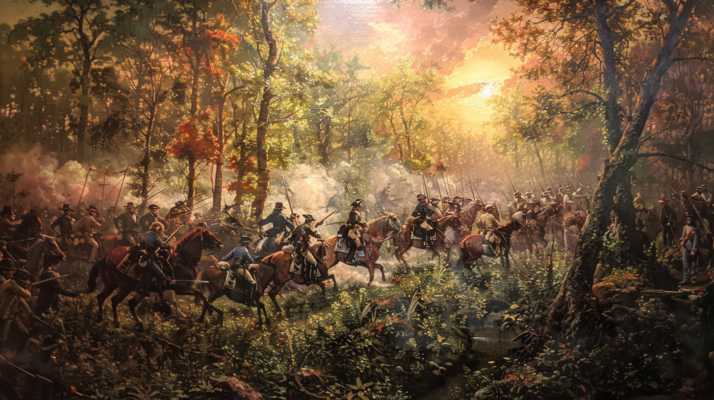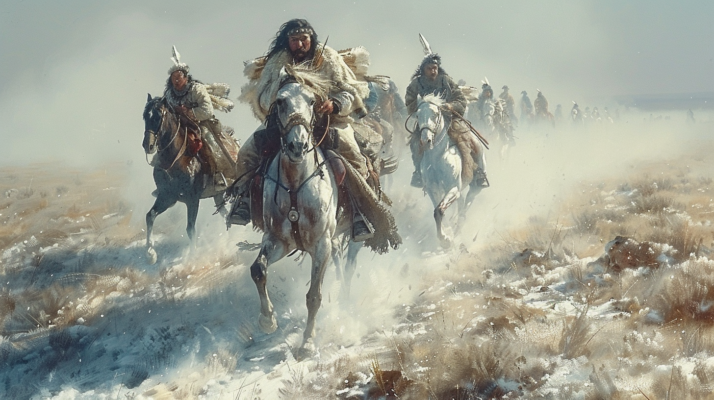By the end of the Indian Wars in the late 19th century, fewer than 238,000 Indigenous people remained of the estimated 5 million-plus living in North America before European contact.
On a cool May day in 1758, a 10-year-old girl named Mary Campbell was caring for her neighbor’s children in rural western Pennsylvania. Her life changed forever when Delaware Indians kidnapped her. They absorbed her into their community for six years. Mary was among some 200 known cases of white captives. Many of these captives became pawns in the ongoing struggle between European powers, American colonists, and Indigenous peoples.
While Mary eventually returned to her white family, stories like hers stoked fear among settlers. This fear fueled paranoia and escalated into outright hatred of Indigenous peoples. From the time Europeans arrived, the frontier—where white settlers met the untamed world—became a place of conflict. The U.S. government authorized over 1,500 wars, attacks, and raids on Indigenous peoples. By the close of the Indian Wars, fewer than 238,000 Indigenous people remained. This was a sharp decline from the millions living in North America when Columbus arrived.
The reasons for this genocide were multi-faceted. Settlers, barred from inheriting property in Europe, arrived hungry for Indigenous lands and the resources they held. Indigenous alliances with the British during the American Revolution and the War of 1812 further fueled American hostility.
Even more fundamentally, Indigenous people were seen as too different. Their skin was darker. Their languages were foreign. Their spiritual beliefs were beyond white settlers’ comprehension. This stoked racial hatred and paranoia, making it easy to paint Indigenous peoples as pagan savages who must be killed in the name of civilization and Christianity.
The Gnadenhutten Massacre
In 1782, Pennsylvania militiamen killed 96 Christianized Delaware Indians. Captain David Williamson ordered the converted Delawares, accused of attacking white settlements, to enter a cooper shop two at a time, where they were beaten to death with wooden mallets and hatchets.
Ironically, the Delawares were the first to capture a white settler and the first to sign a U.S.-Indian treaty four years earlier. This set the precedent for 374 treaties over the next 100 years. Many of these treaties led to tribal lands being ceded to a rapidly expanding United States.
Battle of Tippecanoe
In the early 1800s, Shawnee leader Tecumseh and his brother, known as the Prophet, convinced various tribes to unite against settlers. In 1811, Indiana Territorial Governor William Henry Harrison attacked and burned Prophetstown, inciting Tecumseh to retaliate. Tecumseh’s death in 1813 made the Ohio frontier “safe” for settlers—for a time.
The Creek War
In the South, the War of 1812 bled into the Mvskoke Creek War of 1813-1814. Early Creek victories inspired General Andrew Jackson to retaliate with 2,500 men, mostly Tennessee militia. Jackson’s forces killed 186 Creeks at Tallushatchee and eventually won the Red Stick War at Horseshoe Bend, forcing the Creek to cede over 21 million acres of land.
Forced Removal
The Indian Removal Bill of 1830, pushed by President Andrew Jackson, led to the forced relocation of 60,000 Indigenous people from the East to territories west of the Mississippi. Thousands died on the “Trail of Tears.”
Wounded Knee
Anti-Indian sentiment rose as the Ghost Dance movement spread, calling for a rejection of white ways. In December 1890, the U.S. Army’s Seventh Cavalry massacred 150 to 200 Lakota at Wounded Knee, South Dakota.
 Resilience
Resilience
Despite these atrocities, the American Indian population has survived into the 21st century, persevering through centuries of hardship and systemic challenges. Today, their community has grown to more than 5 million people, a testament to their resilience and enduring cultural heritage.







 Resilience
Resilience